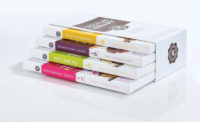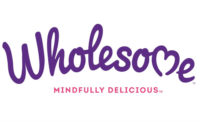If variety is the spice of life, than the chocolate bar sector lives a full one.
Consumers continue to seek indulgent experiences in convenient, affordable and still somewhat healthy packages, and chocolate bar makers — perfectly suited for the role — have risen to meet these demands. But in an effort to check all the consumer’s boxes, the chocolate bar market is bursting with options.
Data from IRI, a Chicago-based research firm, show the 3.5-ounce-and-smaller chocolate category pulled in $4.38 billion in the year ending June 17, up one percent from 2017. Unit sales also stayed virtually flat, exceeding 3.4 billion during the same period.
KitKat, the leading chocolate bar in the category, pulled in nearly $336 million, followed by Hershey’s and Snickers at $334 million and $270 million, respectively.
How then, when customers spend only seconds scanning shelves, can chocolate bar brands cut through the noise? It’s not easy, says Troy Pearley, executive v.p.-general manager at Divine Chocolate USA.
“Your point of difference needs to be communicated,” he said. “Farmer ownership, Fair Trade, all natural — these are key points of difference for Divine Chocolate. We constantly communicate that.”
Packaging is the window into any brand, and the wrapping on Divine Chocolate’s bars employs a solid background dotted with West African Adinkra symbols, each representing different traits and values.
In addition to paying homage to the Kuapa Kokoo cooperative in Ghana, which supplies cocoa for Divine’s bars, the packaging helps move the bars into the everyday gifting category, Pearley said.
“(Chocolate) should be something that’s cherished and loved and shared,” he said. “We want to make that experience as fun and warm and inviting as possible.”
Chef Michael Antonorsi, co-founder of Carlsbad, Calif.-based Chuao Chocolatier, also pointed to the role packaging plays in catching the consumer’s attention. Chuao’s signature bar line features photography of styled ingredients on a solid white background with stripes of color at the top and bottom seams.
“I do believe we stick out pretty loud and clear with our beautiful packaging,” Antonorsi said. “It’s an invitation for the experience they’re going to have when they consume the bars.”
Indianapolis, Ind.-based Endangered Species Chocolate (ESC) plans to launch refreshed packaging next year, but Whitney Bembenick, director of innovation, says it will convey the company’s mission to give 10 percent of its proceeds to wildlife conservation organizations.
“While that’s a differentiator, our consumers have told us they want to know they’re getting a great-tasting chocolate that supports conservation,” she noted.
When it comes to chocolate bars, what’s inside the package also counts. Bembenick says comfortable, well-loved flavors — such as Dark Chocolate with Caramel and Sea Salt and ESC’s newest offering, Dark Chocolate Salted Peanut — will always resonate with consumers, but it also pays to offer unique, innovative flavors to more adventurous eaters.
In 2015, ESC introduced the 60% Dark Chocolate Blackberry Sage bar, inspired by an herbal culinary trend and a need for an “accessible” dark chocolate in the company’s product portfolio.
“It brings out some of the ripened tones of our cocoa beans, but it’s often muddled by the chocolate itself,” Bembenick said. “By adding the footprint of sage — a very light touch of sage — it actually helps pull out some of the herbal tones that exist naturally in the blackberry fruit. When we do that at the right balance and the right combination, that footprint helps you find that difference where the chocolate starts, the blackberry begins and the chocolate finishes.”
Around the same time, ESC introduced the 60% Dark Chocolate Cinnamon, Cayenne and Cherries bar, which was designed to play the warmth and heat of the cinnamon and cayenne off the tartness and sweetness of the cherries.
“We wanted to offer something that was a little more adventurous,” Bembenick said.
As a chef, Antonorsi says he views each of Chuao’s bars as a “little plate,” pairing ethically-sourced chocolate with unique inclusions and hand-pressed toppings to create an overall experience.
“With my culinary inclination to do these premium experiences, I really think that we have a very good base with a very delicious chocolate that we add this combination of ingredients and inclusions to to finish up the whole picture of what’s being offered,” he said.
Antonorsi also pointed to balancing tried-and-true combinations with adventuresome offerings. Last year, Chuao introduced the California Collective, a series of bars highlighting California’s brightness and openness through recognizable ingredients.
“It’s very exciting to come out with something that addresses the needs of the consumer with another layer of fun and activity with the spirit of California,” he said.
On the other end of the spectrum is Chuao’s Totally Tangy Mango bar, featuring mangos dusted with mix of lime, sea salt and a hint of pasilla chile, and the Firecracker bar, which includes sea salt, a dash of chipotle and popping candy. Both are meant to offer a multisensory experience.
“I get really excited when I can get the body to react in multiple ways and you start feeling these layers,” he said. “It stops you and makes you pay attention to the moment.”
And in keeping with the shift toward better-for-you snacking, earlier this year Chuao launched the Moon Bark collection, round discs of 72% dark chocolate with superfood inclusions such as quinoa, golden berries, blueberries and chia.
“There’s so many things that nature offers that as they are that can be combined in chocolate to make a beautiful experience,” Antonorsi said. “And they’re all better for you, they’re all superfoods in many ways.”
Divine Chocolate also incorporates ingredients trending for their health halos. The 70% Dark Chocolate with Ginger & Orange bar is among its Top 5 sellers, Pearley said, and the 70% Dark Chocolate Mango & Coconut bar, launched in 2015, has performed well in multiple channels.
Pearley noted Divine plans to launch an exclusive organic range with some customers next year, featuring high cocoa content and superfood ingredients such as turmeric.
While chocolate serves an ideal carrier for healthful ingredients, chocolate bar makers can’t forget why consumers turn to chocolate bars in the first place.
“Chocolate is an indulgence, and people buy chocolate as a fun thing,” he said. “It shouldn’t be something that serious.”











